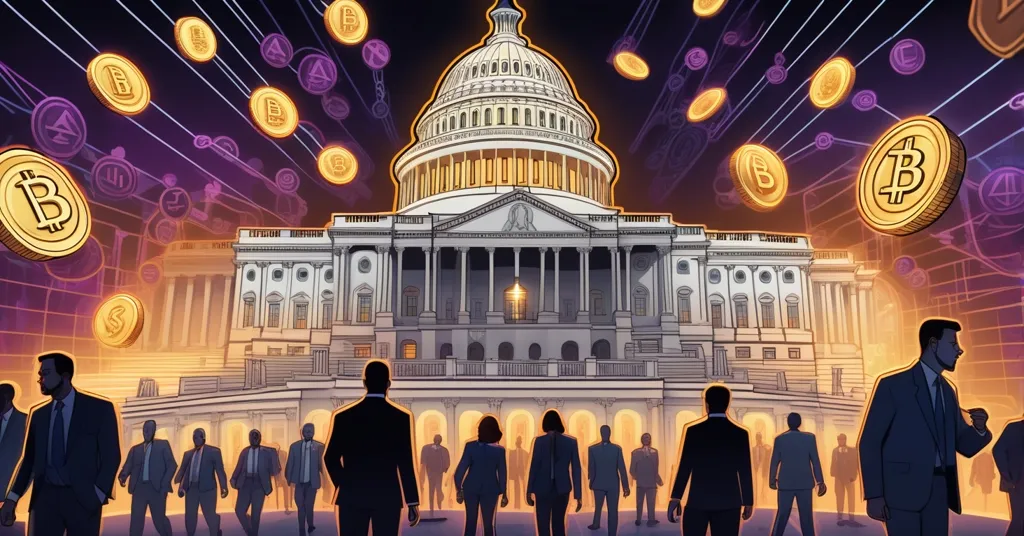Congress Targets Crypto in July: Bank Charters, Trump Tokens Face Heat

Congress Targets Crypto in July: Bank Charters and Trump Tokens Under Fire
July 2024 is shaping up to be a defining moment for cryptocurrency in the United States. Lawmakers are charging ahead with a slate of digital asset hearings and bills, while industry giants like Ripple and Circle push for national bank charters to solidify their place in mainstream finance. Toss in Trump-branded tokens stirring ethical controversies and a massive $400 million crypto crime bust, and you’ve got a month that could either propel Bitcoin and blockchain forward or shackle them to the very systems they were designed to upend.
- Legislative Surge: Senate and House tackle crypto rules with bills like the CLARITY Act during “Crypto Week.”
- Banking Moves: Ripple and Circle chase charters for stablecoin credibility, while Erebor risks SVB-style pitfalls.
- Trump’s Token Drama: World Liberty Financial and $TRUMP memecoin fuel hype on TRON amid ethical scrutiny.
- Crime Crackdown: Secret Service seizes $400 million in digital assets, exposing crypto’s scam-ridden shadows.
Legislative Showdown: Setting the Rules for Crypto’s Future
The stage is set for a pivotal battle over cryptocurrency regulation, starting with the U.S. Senate Banking Committee’s hearing on July 9, titled “From Wall Street to Web3: Building Tomorrow’s Digital Asset Markets.” Ripple CEO Brad Garlinghouse will testify, likely pressing for clear guidelines to integrate blockchain’s disruptive potential with the stability of traditional finance. Just days later, the House of Representatives kicks off “Crypto Week” on July 14, diving into major proposals. The CLARITY Act aims to define crypto market structures, eliminating the legal murkiness that has plagued the industry. The GENIUS Act focuses on regulating stablecoins—digital currencies pegged to assets like the U.S. dollar to avoid wild price swings. Meanwhile, the Anti-CBDC Surveillance State Act takes aim at central bank digital currencies (CBDCs), which many Bitcoin supporters view as government surveillance tools dressed up as innovation. For a deeper look into the current state of crypto regulation in the U.S., the broader legal landscape offers critical context.
Senator Bill Hagerty, a staunch advocate for swift action, didn’t shy away from the urgency, declaring:
“I look forward to working with my colleagues to move the CLARITY Act through the Senate in short order.”
This legislative push isn’t just about policy—it’s a reaction to crypto’s growing influence in politics and finance, especially with the 2024 election looming. A surprising bipartisan effort, spearheaded by Bitcoin champion Senator Cynthia Lummis, suggests a potential breakthrough. Lummis has introduced a bold tax reform proposal: exempt capital gains on crypto transactions under $300 (capped at $5,000 annually) and defer taxation on mining and staking rewards until tokens are sold. Think about it—buying a sandwich with Bitcoin without the IRS nickel-and-diming you over a tiny profit could make everyday use a reality for millions. For miners and stakers, who lock up tokens to secure networks or earn rewards, this could lift a massive burden. But let’s not get too cozy. Budget hawks in Congress might see this as a revenue drain, and passing it through a gridlocked system is no sure bet. As Bitcoin purists, we also have to wonder: does inviting regulation make us legitimate, or does it start building a cage around the freedom we fought for? Check out the latest updates on U.S. crypto legislation to see how these debates are unfolding.
Banking on Blockchain: A Double-Edged Sword
While Congress hashes out the rules, crypto heavyweights are playing a different game—seeking legitimacy through national bank charters from the Office of the Comptroller of the Currency (OCC). If you’re new to the space, a bank charter is a government license that lets a company operate like a traditional bank, managing deposits and services under strict oversight. Ripple, behind the RLUSD stablecoin, and Circle, issuer of the widely-used USDC, are at the forefront. A charter would allow them to hold reserves directly with the Federal Reserve via a “master account,” slashing costs and boosting user confidence. Garlinghouse laid out the stakes plainly:
“A master account would allow us to hold $RLUSD reserves directly with the Fed and provide an additional layer of security to future proof trust in RLUSD.”
Only Anchorage Digital currently holds such a charter among crypto firms, so a win for Ripple or Circle could mark a turning point for mainstream adoption. Stablecoins, for the unfamiliar, are critical bridges between volatile crypto markets and steady fiat currencies, with a combined market cap topping $150 billion. But here’s the kicker—after the catastrophic 2023 collapses of Silicon Valley Bank (SVB), Silvergate, and Signature Bank, all tied to heavy tech and crypto exposure, the idea of crypto-friendly banks raises major red flags. SVB fell apart because it banked almost exclusively on tech startups, with no diversification to weather interest rate hikes or deposit runs. Now, a new player, Erebor, backed by Silicon Valley mogul Peter Thiel, wants to cater to digital asset and AI firms, sounding like SVB 2.0. For more on the risks tied to Ripple and Circle’s charter applications post-SVB collapse, expert analysis highlights the potential pitfalls. Bloomberg’s Paul Davies didn’t pull punches with his warning:
“Circle, Erebor and the rest look like they’re running straight back toward this bad business model trap.”
Davies hits a raw nerve. Tech-focused banks are like putting all your eggs in one shaky basket—if a crypto winter hits or AI hype fizzles, they’re done for. From a Bitcoin maximalist perspective, this reeks of betrayal. Why chain decentralized tech to the Federal Reserve’s oversight when Bitcoin was forged to break those very chains? Couldn’t we push for fully decentralized reserve systems instead of begging for a seat at the old boys’ table? Sure, charters might fast-track adoption, aligning with effective accelerationism’s push for speed, but at what cost to our ethos of freedom and privacy? Community discussions on Ripple and Circle’s charter challenges reveal similar concerns. It’s a gamble, and history shows these bets can blow up spectacularly.
Trump’s Token Gamble: Hype or Heresy?
Switching gears to a wilder subplot, the Trump family’s dive into crypto is turning heads—and stomachs. World Liberty Financial (WLF), a DeFi project linked to the Trumps, is voting to make its WLFI governance token tradable, reserving 30% for early backers. For those new to the term, DeFi—short for Decentralized Finance—refers to blockchain-based systems that cut out middlemen like banks, using smart contracts (self-executing code) to run transactions. TRON founder Justin Sun, a controversial figure known for bold and often divisive moves, threw $75 million into WLF. Alongside this, WLF’s USD1 stablecoin and the $TRUMP memecoin are launching trading pairs with USDT and TRX on the TRON network. If you’re scratching your head, memecoins are speculative tokens driven by internet buzz rather than real-world utility, and slapping Trump’s name on one feels less like innovation and more like a political cash grab in blockchain clothing. For the full scoop on World Liberty Financial’s WLFI token and USD1 stablecoin, recent updates provide key details.
Public opinion couldn’t be more split. A Cedar Innovation Fund survey of 1,000 voters found 57-60% either unaware or indifferent to Trump’s crypto profits, while a Data for Progress poll claims 62% support laws to block personal gains from such ventures. If politics is a circus, $TRUMP is the overpriced popcorn—some lap it up, others feel sick just smelling it. The ethical stench of conflict of interest, especially with Trump’s 2024 ambitions, is glaring. Could these tokens become magnets for scams, exploiting hype while dragging crypto’s credibility through the mud? Insights on the impact of Trump-linked tokens on crypto credibility shed light on the broader implications. As champions of decentralization, we’ve got no patience for this nonsense. If it’s a shill, call it a damn shill—let’s not dress up profiteering as progress.
Crime in the Crypto Shadows: A Persistent Plague
Let’s not ignore the darker side of this space. The U.S. Secret Service has stockpiled nearly $400 million in seized digital assets, including $225.3 million recovered from a money laundering network linked to fraud in June. Scammers even impersonated Trump associate Steve Witkoff, swindling a donor out of $250,300 in USDT before Tether and Binance managed to freeze over 40,000 of the stolen funds. This isn’t an isolated incident—recent hacks like the $305 million DMM Bitcoin theft in Japan and countless “rug pulls” (where project creators vanish with investor cash) prove the crypto world is still a lawless frontier. Government seizures flex enforcement muscle, but nagging questions remain: How are these funds stored? Are victims ever made whole? Are we just handing centralized authorities the keys to assets they didn’t protect in the first place? For every stride toward legitimacy, crypto crime reminds us of the predators lurking in unregulated corners, ready to pounce on the unwary.
Global Lens: Where Does the U.S. Stand?
Stepping back, the U.S. isn’t wrestling with these issues in a vacuum. The European Union’s Markets in Crypto-Assets (MiCA) framework, rolling out in 2024, offers a unified rulebook for digital assets, potentially outshining America’s fragmented approach. Meanwhile, China’s outright ban on crypto drives innovation underground or overseas. July’s moves in Congress could cement the U.S. as a leader in balancing innovation with oversight—or leave it scrambling if partisan bickering stalls progress. For a closer look at the upcoming Congressional crypto push and bank charter debates, the policy landscape is heating up. For Bitcoin, the original rebel of finance, and altcoins like Ethereum, which dominates smart contracts and DeFi with platforms powering much of stablecoin activity, the stakes are sky-high. Ethereum’s ecosystem might even eclipse Bitcoin in certain use cases, but does that dilute the purity of a peer-to-peer money revolution? It’s a tension worth unpacking as global policies take shape.
What’s at Stake for Bitcoin’s Vision?
July’s whirlwind—legislation, bank charters, political stunts, and rampant crime—lays bare the crossroads facing cryptocurrency. Bitcoin and blockchain stand as our strongest weapons to dismantle centralized control, safeguard privacy, and accelerate a freer financial future. But every step forward comes with strings attached. Regulation might pave the way for adoption but risks strangling decentralization in red tape. Bank charters could build trust but tie us to the flawed legacy systems we swore to escape. For more on the intersection of stablecoin regulation and bank charters, the challenges are becoming clearer. And as for Trump’s tokens or unchecked scams, they’re a blight on our principles—pure and simple. We’re all for effective accelerationism, pushing this tech to warp speed, but not if it means selling out the soul of the movement. So, are we crafting a liberated tomorrow, or just trading one set of masters for another? The fight for answers is on, and it’s messier than ever.
Key Takeaways and Questions to Ponder
- Why is Congress zeroing in on crypto regulation this July?
The 2024 election and crypto’s soaring influence are spurring bipartisan urgency to set rules, with bills like the CLARITY Act and GENIUS Act targeting market structure and stablecoin oversight. - Can Senator Lummis’s tax reform drive Bitcoin adoption?
It’s a strong yes if it passes—exempting small gains and deferring miner taxes could make daily use and mining less taxing, though pushback over lost revenue looms large. - Are crypto bank charters a win for the industry?
They’re a mixed bag, offering legitimacy and efficiency for firms like Ripple and Circle, but risking centralization and SVB-style meltdowns if diversification is ignored. - What’s the real fallout from Trump-linked crypto ventures like $TRUMP?
They stoke speculative frenzy on platforms like TRON, but ethical concerns over political profiteering could erode trust across the broader crypto space. - How bad is crypto crime with Secret Service seizures hitting $400 million?
It’s a glaring problem, spotlighting fraud and scams as huge barriers, while government actions leave unresolved issues about transparency and victim restitution. - How does U.S. crypto policy stack up globally this July?
The U.S. trails the EU’s cohesive MiCA framework but leads over China’s bans, though partisan gridlock could jeopardize its chance to shape innovation with balanced control.



